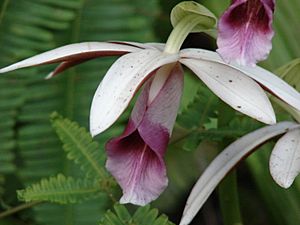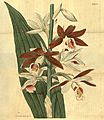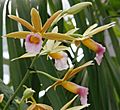Swamp orchid facts for kids
Quick facts for kids Swamp orchid |
|
|---|---|
 |
|
| Phaius tankervilleae growing on Lanai | |
| Scientific classification | |
| Genus: |
Phaius
|
| Species: |
tankervilleae
|
| Synonyms | |
The Phaius tankervilleae, also known as the greater swamp-orchid or nun's-hood orchid, is a beautiful type of orchid. It grows naturally in many places, from Asia all the way to islands in the Pacific Ocean. This orchid is special because it has large, folded leaves and tall stems that can hold up to 25 colorful flowers. These flowers can be white, brown, purple, and yellow. The plant was named after Lady Tankerville, who had the first one bloom in her greenhouse. It was also the very first tropical orchid to flower in England!
Contents
What Does the Swamp Orchid Look Like?
The Phaius tankervilleae is an evergreen plant, meaning its leaves stay green all year. It grows on land and has cone-shaped or round parts called pseudobulbs. These pseudobulbs are usually about 6 to 8 centimeters (2.4 to 3.1 inches) long and 3 to 6 centimeters (1.2 to 2.4 inches) wide.
From each pseudobulb, two to eight long, folded leaves grow. These leaves can be quite big, from 30 to 100 centimeters (12 to 39 inches) long and 8 to 20 centimeters (3.1 to 7.9 inches) wide.
The orchid's flowers are also impressive. A tall stem, which can be 50 to 200 centimeters (20 to 79 inches) high, holds between 10 and 25 flowers. Each flower is about 7 to 12.5 centimeters (2.8 to 4.9 inches) wide. The outside of the flowers is usually whitish, while the inside is a reddish-brown color.
The different parts of the flower include:
- Sepals and Petals: These are oblong or lance-shaped, about 4 to 6.5 centimeters (1.6 to 2.6 inches) long.
- Labellum: This is a special lip-like petal, usually pink or reddish with a white tip and white stripes inside. It's about 3.5 to 6 centimeters (1.4 to 2.4 inches) long. The labellum has three parts, with the middle part shaped like a tube and the side parts having wavy edges.
- Spur: Near the base of the labellum, there's a yellowish-white spur, about 0.5 to 1 centimeter (0.2 to 0.4 inches) long.
In Australia, these orchids usually bloom from September to November. In Asia, they flower from March to June.
How the Swamp Orchid Got Its Name
The story of the swamp orchid's name goes back to 1778. That year, a doctor named John Fothergill sent samples of this orchid from China to England. In 1788, one of these orchids bloomed.
After it flowered, Joseph Banks officially described the plant. He gave it the name Limodorum tankervilleae. Later, in 1859, a botanist named Carl Ludwig Blume changed its name to Phaius tankervilleae.
The second part of its name, tankervilleae, is a special tribute. It honors Lady Emma Tankerville. The orchid had bloomed for the first time in her greenhouse, which was located in Walton-on-Thames near London. This was a very exciting event because it was the first time a tropical orchid had ever flowered in England!
Sometimes, you might see the name spelled a little differently, like Phaius tancervilleae. This happened because of how names were sometimes changed to sound more like Latin.
Where Does the Swamp Orchid Live?
The Phaius tankervilleae loves to grow in wet places, like swampy forests or grasslands. You can find it naturally in many parts of the world, including:
- The Indian subcontinent
- New Guinea
- China
- Japan
- Southeast Asia
- Indonesia
- Malaysia
- The Philippines
- Australia
- Some islands in the Pacific Ocean
It has also started growing in new places where it wasn't originally found, like Hawaii, Panama, the Caribbean, and Florida. In Australia, a specific type of this orchid, P. tankervilleae var. australis, grows as far south as Yamba, New South Wales and further north in tropical Queensland.
Protecting the Swamp Orchid
In some areas, especially in Australia, a type of this orchid called Phaius tankervilleae var. australis is considered endangered. This means it's at risk of disappearing forever.
There are a few reasons why this orchid is in danger:
- Trampling: Animals like cattle can step on and damage the plants.
- Illegal Collecting: Some people illegally take the orchids from their natural homes.
- Weeds: Other plants, called weeds, can grow and take over the orchid's space.
- Habitat Loss: When swamps are drained for other uses, the orchid loses its home.
Efforts are being made to protect these beautiful plants and their habitats.
Growing the Swamp Orchid
The swamp orchid is a plant that can be grown fairly easily by people. It prefers places with some shade, not full sun.
People can grow new swamp orchids in a few ways:
- From Seed: Like many plants, new orchids can grow from seeds.
- From Cuttings: You can also grow new plants by cutting a piece from the base of an existing plant.
- From Flower Stems: After the orchid flowers, you can take the flower stem and lay it on a damp material like Sphagnum moss or put it in water. Small new plants will start to grow from the stem's nodes (the bumps on the stem). Once these new plantlets are big enough, they can be moved and planted in their own pots.
The large, colorful flowers usually appear in the spring, making them a lovely addition to a garden.
Gallery
See also
 In Spanish: Phaius tankervilleae para niños
In Spanish: Phaius tankervilleae para niños






